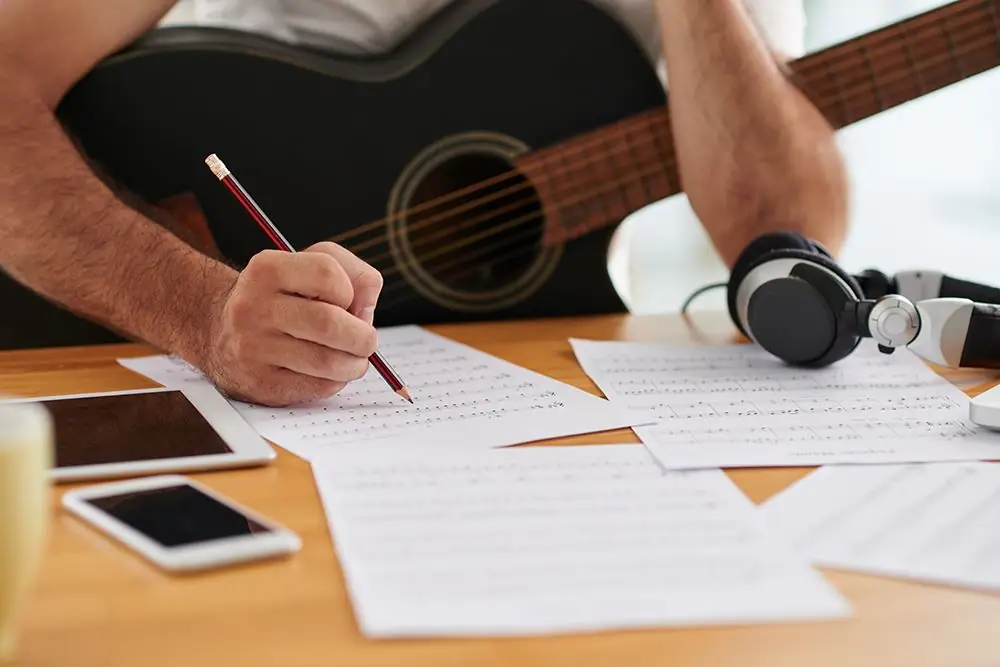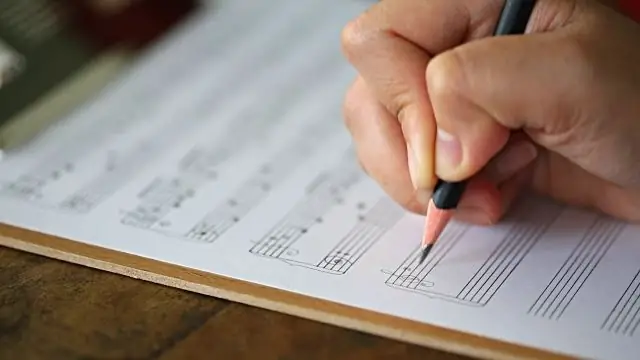How do I compose a song? Can the creative process have rules? For songwriting, it's important to learn how to find inspiration and come up with ideas for lyrics. You also need to have an idea of your target audience, because the same song can be liked by some people and cause negative emotions in others. You may not even have a musical or philological education to write songs. You just need to learn how to convey your thoughts and mood with the help of text and melody.

Describe the performer of the song
Even if you are writing a song for yourself and not for another artist, think about how the audience perceives the artist. As an attractive seductress, a bad guy, an eternally suffering romance, a schoolgirl, a wealthy and successful celebrity, a good-natured person with a wide soul? This is an important question because the style of the text will depend on the answer to it. Colloquial words or obscene language can be enthusiastically received in one environment from a particular character. If a singer who sings for intelligent grandmothers will swear in the lyrics, the target audience will not understand and forgive him. A musician with the image of a dangerous gangster will face aggression, but a good-natured guy with such a song will only ruin his reputation.
Decide on the mood you want to convey to your listeners
Music is a product that, in the opinion of the listener, should meet their expectations. On digital platforms and social media, there are playlists with songs that are meant for a party, for a date, for a spring or summer, and even for cleaning. Which playlist will your song go to? Will it be possible to dance to it, be sad or angry at the whole world? The theme of the song, its lyrics and arrangement will depend on the mood.

Come up with an idea for a song lyrics
If you are a songwriter, then you have something to say to the world. That's why you write the lyrics. If the idea does not come quickly and immediately, remember a life experience that caused certain emotions in you. If you are writing a sad ballad, then remember how you suffered from unrequited sympathy, how you missed your loved one. These stories can be the subject of a ballad. For a humorous song, a funny incident from life is suitable. You can just list the items and activities that make you happy or sad. A personal diary will help the songwriter to find ideas, the experiences recorded in them, evoke vivid emotions even after a long time.
But what if you are a bearded man and are writing a song for a schoolgirl? You can take as a basis a story from the life of a girl you know. If a story really touches you, then you can write a sincere text about it. Movies, books, pictures, videos and social media posts can also form the basis for text, but chances are that someone has already used them.

Sketch the text
It's best to start with the chorus. This part of the song should be the brightest and most memorable. If you can't come up with a chorus, then start composing the lyrics with a verse, and put the chorus aside. There are world hits in which there is no text at all in the chorus, but there are just funny combinations of sounds. In verses, it is important to fully formulate what you want to talk about, you can first write it down without rhyming, so that it is clear what will be discussed in the first verse, and what in the second.

Pick a song tempo and come up with a beat
It is important to determine the tempo, even if you collaborate with an arranger and only compose the melody and lyrics yourself. When will the listener play our song? If you can dance to it, then you need a fairly fast pace, if you turn it on on a trip and look out the window at the trees flying by, then another. It is better not just to characterize the tempo, but to write down the value of the metronome, for example, one hundred beats per minute. It will be great if you compose and record the drum part in a sheet music editor or in a music production program.
Come up with a melody
It's better to start composing a melody with the chorus. The melody is worth coming up with, even if there are no words in the chorus yet. You can not forgive me to hum a melody without text, but sing in a fictitious language, pronounce arbitrary combinations of sounds. It sounds funny, but it helps to think through the rhythmic structure of the melody. This kind of improvisation can liberate you and give you an idea of the original text.
Once the chorus is ready, move on to the verse. It will be good if you do the chorus output, which the musicians call "bridge". It should gravitate harmoniously to the chorus. This is achieved by resolving unstable fret steps to stable ones. The most stable scale of the scale is the first; tonality is called by its name. The third and fifth degrees are also stable degrees of the fret. The scale contains seven steps, the same as the notes in the major and minor scales. In the transition, you need to create a sense of tension. Even if you don't know how to play instruments, you can only play bass. The tension is greatest when the bass is at the second or seventh fret. Come up with a transition that ends at these rungs, and you will hear the chorus sound like you've been waiting for it for a long time.
There may also be a "third movement" in the song. This is the part of the song that is different from the verse and chorus. It is needed to make the third chorus sound bright. Using the “third movement” will help avoid the monotony of listening to the song. This part can also be built on the principle of gravitation of unstable degrees of the scale to the tonic. It can be allocated by other means. In a song with many instruments, one or two instruments may remain in the “third movement”. In a track with sonorous vocals, the singer can sing quietly in this part. In a song with vocals, you can insert a recitative. The principle of using contrast is important here.

Refine the text
When the melody is ready, start finalizing the text. Finally, think over the chorus that expresses the main idea. He must be remembered, it is he who will know and sing the audience.
Refine the verse and melody. It's okay if the melody of the verse changes a little as it improves. Avoid commonplace rhymes like "blood and love" unless you're writing a parody of popular retro songs. Verbal rhymes are also not desirable, but in dance or other light music, the meaning of which is not accepted to listen attentively, they may be appropriate. Profanity, foreign and outdated slang, scientific and professional terms should be used considering who your target audience is.
In classical poems, rhyming lines often contain the same number of syllables. This is optional in a song. If there are fewer syllables in one line, you can stretch the vowel or sonorant consonant sound into several syllables by singing melismas, that is, the vocal decorations of the melody.
There may be a lack of rhyme, if it is stylistically appropriate. Rhyme is perceived by the listener as a pleasant euphony, as a consonance in sounds. But dissonances such as minor are also used in music, although they don't sound very pleasant. Dissonances are needed to express suffering, tension and instability. It's the same with the lack of rhyme. When a person sings about suffering, using ideal rhymes, it does not sound very natural, as if faked. But some listeners react negatively to the lack of rhyme, do not consider it poetry.
Imagine your song is on the radio
If there is a melody and lyrics, the song can be considered finished. You can sing it to the accompaniment of a guitar or other instrument. Further improvements are related to the arrangement. Even if you turn to the services of an arranger, imagine that the song is already ready and sounds on the radio or in playlists on digital platforms. What musical instruments are there? Which part are the drums playing, are they acoustic or electronic? Is there any backing vocals? Where should the volume rise and where should it fall? If you present the final version of the song, it will be easier for you to explain to the specialist what you want and create exactly the song that you planned.






